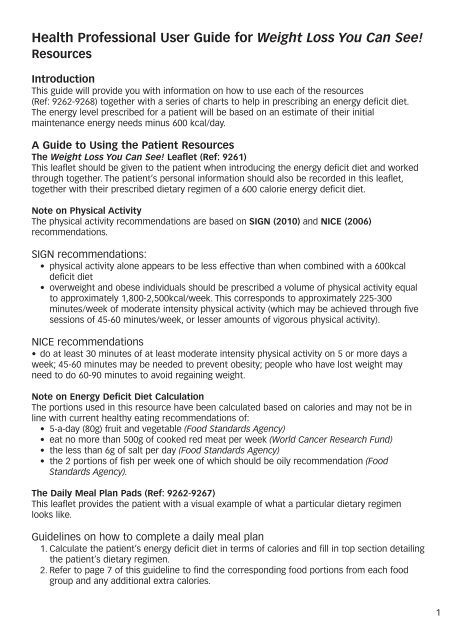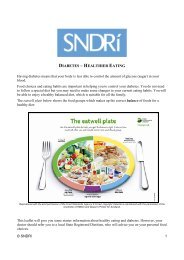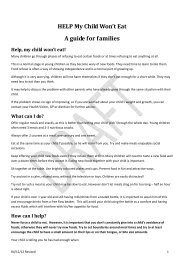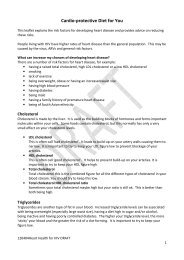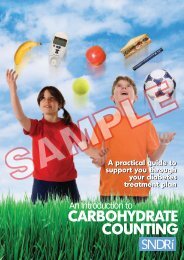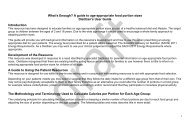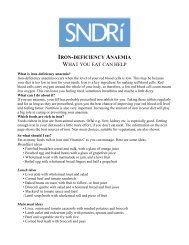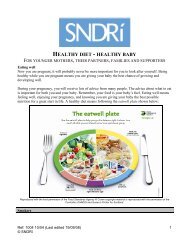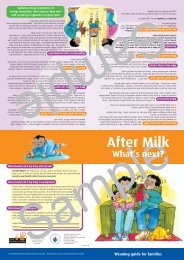User Guide for Weight Loss You Can See! - NDR-UK
User Guide for Weight Loss You Can See! - NDR-UK
User Guide for Weight Loss You Can See! - NDR-UK
Create successful ePaper yourself
Turn your PDF publications into a flip-book with our unique Google optimized e-Paper software.
Health Professional <strong>User</strong> <strong>Guide</strong> <strong>for</strong> <strong>Weight</strong> <strong>Loss</strong> <strong>You</strong> <strong>Can</strong> <strong>See</strong>!<br />
Resources<br />
Introduction<br />
This guide will provide you with in<strong>for</strong>mation on how to use each of the resources<br />
(Ref: 9262-9268) together with a series of charts to help in prescribing an energy deficit diet.<br />
The energy level prescribed <strong>for</strong> a patient will be based on an estimate of their initial<br />
maintenance energy needs minus 600 kcal/day.<br />
A <strong>Guide</strong> to Using the Patient Resources<br />
The <strong>Weight</strong> <strong>Loss</strong> <strong>You</strong> <strong>Can</strong> <strong>See</strong>! Leaflet (Ref: 9261)<br />
This leaflet should be given to the patient when introducing the energy deficit diet and worked<br />
through together. The patient’s personal in<strong>for</strong>mation should also be recorded in this leaflet,<br />
together with their prescribed dietary regimen of a 600 calorie energy deficit diet.<br />
Note on Physical Activity<br />
The physical activity recommendations are based on SIGN (2010) and NICE (2006)<br />
recommendations.<br />
SIGN recommendations:<br />
• physical activity alone appears to be less effective than when combined with a 600kcal<br />
deficit diet<br />
• overweight and obese individuals should be prescribed a volume of physical activity equal<br />
to approximately 1,800-2,500kcal/week. This corresponds to approximately 225-300<br />
minutes/week of moderate intensity physical activity (which may be achieved through five<br />
sessions of 45-60 minutes/week, or lesser amounts of vigorous physical activity).<br />
NICE recommendations<br />
• do at least 30 minutes of at least moderate intensity physical activity on 5 or more days a<br />
week; 45-60 minutes may be needed to prevent obesity; people who have lost weight may<br />
need to do 60-90 minutes to avoid regaining weight.<br />
Note on Energy Deficit Diet Calculation<br />
The portions used in this resource have been calculated based on calories and may not be in<br />
line with current healthy eating recommendations of:<br />
• 5-a-day (80g) fruit and vegetable (Food Standards Agency)<br />
• eat no more than 500g of cooked red meat per week (World <strong>Can</strong>cer Research Fund)<br />
• the less than 6g of salt per day (Food Standards Agency)<br />
• the 2 portions of fish per week one of which should be oily recommendation (Food<br />
Standards Agency).<br />
The Daily Meal Plan Pads (Ref: 9262-9267)<br />
This leaflet provides the patient with a visual example of what a particular dietary regimen<br />
looks like.<br />
<strong>Guide</strong>lines on how to complete a daily meal plan<br />
1. Calculate the patient’s energy deficit diet in terms of calories and fill in top section detailing<br />
the patient’s dietary regimen.<br />
2. Refer to page 7 of this guideline to find the corresponding food portions from each food<br />
group and any additional extra calories.<br />
1
3. For energy deficit diets not visually represented within the meal plans, adapt the meal plan<br />
to fit the patient’s calorie allocation by adding additional food portions and extras at the<br />
bottom of the page in the ‘Additional food portions or extras <strong>for</strong> a xxxx or xxxx diet’.<br />
4. Total up the final row <strong>for</strong> the patient so they can see their food portion allowance from<br />
each food group and extras.<br />
For example your patient requires 2200 calories which equates to 9,9,3,3,3 from the respective<br />
food portions and 280calories from extras. However, when you look at the example 2000<br />
calories diet you will see that this equates to 8,8,3,3,3 with 200 calories from extras. There is an<br />
additional requirement <strong>for</strong> 1 extra food portion in both the bread, rice, potatoes, pasta and<br />
other starchy foods (B,R) and the fruit and vegetable (F&V) groups and an additional 80 calories<br />
from extras. <strong>You</strong> would insert these additional requirements in the row at the bottom of the<br />
page titled ‘Additional food portions and extras <strong>for</strong> a xxxx or xxxx diet’<br />
The Blank Food and Drink Diary (Ref: 9268)<br />
The blank daily diary should be given to the patient to allow them to monitor their diet and to<br />
see where they need to make changes to their diet to achieve weight loss.<br />
2
Chart 1<br />
BMI reference chart – weights <strong>for</strong> a given height, <strong>for</strong> a healthy weight range, overweight or<br />
obese.<br />
Imperial<br />
Height<br />
<strong>Weight</strong> <strong>for</strong><br />
BMI 18.5<br />
<strong>Weight</strong> <strong>for</strong><br />
BMI 25<br />
<strong>Weight</strong> <strong>for</strong><br />
BMI 30<br />
Height<br />
<strong>Weight</strong> <strong>for</strong><br />
BMI 18.5<br />
<strong>Weight</strong> <strong>for</strong><br />
BMI 25<br />
<strong>Weight</strong> <strong>for</strong><br />
BMI 30<br />
4’8” 5st 12lbs 7st 13lbs 9st 7lbs 5’8” 8st 9lbs 11st 10lbs 14st 1lbs<br />
4’9” 6st 1lbs 8st 4lbs 9st 12lbs 5’9” 8st 13lbs 12st 1lbs 14st 7lbs<br />
4’10” 6st 4lbs 8st 8lbs 10st 3lbs 5’10” 9st 3lbs 12st 6lbs 14st 13lbs<br />
4’11” 6st 7lbs 8st 12lbs 10st 8lbs 5’11” 9st 6lbs 12st 11lbs 15st 4lbs<br />
5’ 6st 10lbs 9st 2lbs 10st 13lbs 6’ 9st 10lbs 13st 2lbs 15st 10lbs<br />
5’1” 7st 0lbs 9st 6lbs 11st 4lbs 6’1” 10st 0lbs 13st 7lbs 16st 3lbs<br />
5’2” 7st 3lbs 9st 11lbs 11st 9lbs 6’2” 10st 4lbs 13st 13lbs 16st 9lbs<br />
5’3” 7st 6lbs 10st 1lbs 12st 1lbs 6’3” 10st 8lbs 14st 4lbs 17st 1lbs<br />
5’4” 7st 9lbs 10st 6lbs 12st 6lbs 6’4” 10st 12lbs 14st 9lbs 17st 8lbs<br />
5’5” 7st 13lbs 10st 10lbs 12st 11lbs 6’5” 11st 2lbs 15st 0lbs 18st 0lbs<br />
5’6” 8st 2lbs 11st 1lbs 13st 3lbs 6’6” 11st 6lbs 15st 5lbs 18st 7lbs<br />
5’7” 8st 6lbs 11st 6lbs 13st 9lbs 6’7” 11st 10lbs 15st 11lbs 19st 0lbs<br />
Metric<br />
Height<br />
<strong>Weight</strong> <strong>for</strong><br />
BMI 18.5<br />
<strong>Weight</strong> <strong>for</strong><br />
BMI 25<br />
<strong>Weight</strong> <strong>for</strong><br />
BMI 30<br />
Height<br />
<strong>Weight</strong> <strong>for</strong><br />
BMI 18.5<br />
<strong>Weight</strong> <strong>for</strong><br />
BMI 25<br />
<strong>Weight</strong> <strong>for</strong><br />
BMI 30<br />
1.42m 37.3 50.4 60.5 1.73m 55.4 74.8 89.8<br />
1.45m 38.9 52.6 63.1 1.75m 56.7 76.6 91.9<br />
1.47m 40.0 54.0 64.8 1.78m 58.6 79.2 95.0<br />
1.50m 41.6 56.2 67.5 1.80m 59.9 81.0 97.2<br />
1.52m 42.7 57.8 69.3 1.83m 62.0 83.8 100.5<br />
1.55m 44.4 60.0 72.0 1.85m 63.3 85.6 102.7<br />
1.57m 45.6 61.6 74.1 1.88m 65.4 88.4 106.0<br />
1.60m 47.4 64.0 76.8 1.91m 67.5 91.2 109.4<br />
1.63m 49.1 66.4 78.7 1.93m 68.9 93.1 111.7<br />
1.65m 50.4 68.0 81.7 1.96m 71.1 96.0 115.2<br />
1.68m 52.2 70.6 84.7 1.98m 72.5 98.0 117.6<br />
3
Chart 2<br />
<strong>Weight</strong> loss needed to achieve 5% and 10% weight loss, based on start weight (in half stone<br />
bands).<br />
<strong>Weight</strong><br />
To lose 5% means losing<br />
To lose 10% means losing<br />
4<br />
Imperial (stones)<br />
Metric (kg)<br />
Imperial (lbs) Metric (kg) Imperial (lbs) Metric (kg)<br />
10 64 7.0 3.2 14.0 6.4<br />
10.5 67 7.4 3.3 14.7 6.7<br />
11 70 7.7 3.5 15.4 7.0<br />
11.5 73 8.1 3.7 16.1 7.3<br />
12 76 8.4 3.8 16.8 7.6<br />
12.5 79 8.8 4.0 17.5 7.9<br />
13 83 9.1 4.1 18.2 8.3<br />
13.5 86 9.5 4.3 18.9 8.6<br />
14 89 9.8 4.4 19.6 8.9<br />
14.5 92 10.2 4.6 20.3 9.2<br />
15 95 10.5 4.8 21.0 9.5<br />
15.5 98 10.9 4.9 21.7 9.8<br />
16 102 11.2 5.1 22.4 10.2<br />
16.5 105 11.6 5.2 23.1 10.5<br />
17 108 11.9 5.4 23.8 10.8<br />
17.5 111 12.3 5.6 24.5 11.1<br />
18 114 12.6 5.7 25.2 11.4<br />
18.5 117 13.0 5.9 25.9 11.7<br />
19 121 13.3 6.0 26.6 12.1<br />
19.5 124 13.7 6.2 27.3 12.4<br />
20 127 14.0 6.4 28.0 12.7<br />
20.5 130 14.4 6.5 28.7 13.0<br />
21 133 14.7 6.7 29.4 13.3<br />
21.5 137 15.1 6.8 30.1 13.7<br />
22 140 15.4 7.0 30.8 14.0<br />
22.5 143 15.8 7.1 31.5 14.3<br />
23 146 16.1 7.3 32.2 14.6<br />
23.5 149 16.5 7.5 32.9 14.9<br />
24 152 16.8 7.6 33.6 15.2<br />
24.5 156 17.2 7.8 34.3 15.6<br />
25 159 17.5 7.9 35.0 15.9<br />
25.5 162 17.9 8.1 35.7 16.2<br />
26 165 18.2 8.3 36.4 16.5<br />
26.5 168 18.6 8.4 37.1 16.8<br />
27 171 18.9 8.6 37.8 17.1<br />
27.5 175 19.3 8.7 38.5 17.5<br />
28 178 19.6 8.9 39.2 17.8<br />
28.5 181 20.0 9.0 39.9 18.1<br />
29 184 20.3 9.2 40.6 18.4<br />
29.5 187 20.7 9.4 41.3 18.7
<strong>Weight</strong><br />
To lose 5% means losing<br />
To lose 10% means losing<br />
Imperial (stones)<br />
Metric (kg)<br />
Imperial (lbs) Metric (kg) Imperial (lbs) Metric (kg)<br />
30 191 21.0 9.5 42.0 19.1<br />
30.5 194 21.4 9.7 42.7 19.4<br />
31 197 21.7 9.8 43.4 19.7<br />
31.5 200 22.1 10.0 44.1 20.0<br />
32 203 22.4 10.2 44.8 20.3<br />
32.5 206 22.8 10.3 45.5 20.6<br />
33 210 23.1 10.5 46.2 21.0<br />
33.5 213 23.5 10.6 46.9 21.3<br />
34 216 23.8 10.8 47.6 21.6<br />
34.5 219 24.2 11.0 48.3 21.9<br />
35 222 24.5 11.1 49.0 22.2<br />
35.5 225 24.9 11.3 49.7 22.5<br />
36 229 25.2 11.4 50.4 22.9<br />
36.5 232 25.6 11.6 51.1 23.2<br />
37 235 25.9 11.7 51.8 23.5<br />
37.5 238 26.3 11.9 52.5 23.8<br />
38 241 26.6 12.1 53.2 24.1<br />
38.5 244 27.0 12.2 53.9 24.4<br />
39 248 27.3 12.4 54.6 24.8<br />
39.5 251 27.7 12.5 55.3 25.1<br />
40 254 28.0 12.7 56.0 25.4<br />
40.5 257 28.4 12.9 56.7 25.7<br />
41 260 28.7 13.0 57.4 26.0<br />
41.5 264 29.1 13.2 58.1 26.4<br />
42 267 29.4 13.3 58.8 26.7<br />
42.5 270 29.8 13.5 59.5 27.0<br />
43 273 30.1 13.7 60.2 27.3<br />
43.5 276 30.5 13.8 60.9 27.6<br />
44 279 30.8 14.0 61.6 27.9<br />
44.5 283 31.2 14.1 62.3 28.3<br />
45 286 31.5 14.3 63.0 28.6<br />
45.5 289 31.9 14.4 63.7 28.9<br />
46 292 32.2 14.6 64.4 29.2<br />
46.5 295 32.6 14.8 65.1 29.5<br />
47 298 32.9 14.9 65.8 29.8<br />
47.5 302 33.3 15.1 66.5 30.2<br />
48 305 33.6 15.2 67.2 30.5<br />
48.5 308 34.0 15.4 67.9 30.8<br />
49 311 34.3 15.6 68.6 31.1<br />
49.5 314 34.7 15.7 69.3 31.4<br />
50 318 35.0 15.9 70.0 31.8<br />
5
Chart 3 - Estimated Energy Requirement (EER)<br />
EERs to maintain body weight are calculated using a <strong>for</strong>mula to account <strong>for</strong> four factors: gender,<br />
age, activity level and current weight. Modest energy deficit diets, which would achieve about<br />
1Ib (0.5kg) a week weight loss, are based on daily dietary intake of 600 calories less than the<br />
person’s daily energy requirement. Work out patient’s EER <strong>for</strong> a 600 calorie energy deficit diet<br />
using the in<strong>for</strong>mation below. The in<strong>for</strong>mation uses the Schofield and WHO energy requirement<br />
equations however, there are alternative equations that you may prefer to use.<br />
1.Basal Metabolic Rate (BMR): Based on patient’s age, gender and current weight (in kg) as<br />
listed in the chart below, predict the patient’s BMR. These are based on modified Schofield<br />
equations. (Department of Health Dietary Reference Values, 1991).<br />
Age Range<br />
Years<br />
18-29<br />
30-59<br />
60+<br />
Men<br />
BMR<br />
15.1 x weight(kg) + 692<br />
11.5 x weight(kg) + 873<br />
11.9 x weight(kg) + 700<br />
Women<br />
BMR<br />
14.8 x weight(kg) + 487<br />
8.3 x weight(kg) + 846<br />
9.2 x weight(kg) +687<br />
2.Physical Activity Level (PAL): Incorporate their PAL based on the gender and activity (WHO,<br />
1985) level shown in the chart below. Do this by multiplying the patient’s estimated BMR with<br />
the appropriate figure from the table below. Few patients are likely to have activity levels<br />
above inactive.<br />
Activity Level<br />
This Means<br />
Men<br />
Women<br />
PAL<br />
PAL<br />
Inactive<br />
Assume sitting most of the day with less<br />
than 2 hours on their feet<br />
1.4<br />
1.4<br />
Light<br />
Assume some daily exercise (at work or<br />
tasks about the house or garden) with at<br />
east 2 hours on their feet<br />
1.5<br />
1.5<br />
Moderate<br />
Assume 6 hours on their feet or regular<br />
strenuous exercise<br />
1.78<br />
1.64<br />
Heavy<br />
Those in heavy labouring jobs or serious<br />
athletes in training<br />
2.1<br />
1.82<br />
3.EER: Calculate the person’s daily estimated energy requirement to maintain weight by<br />
multiplying BMR and PAL.<br />
4.EER <strong>for</strong> weight loss: Subtract 600 calories from the above figure to estimate the person’s<br />
energy requirement <strong>for</strong> modest weight loss.<br />
6
Chart 4 - Food Group Portions<br />
The table below suggests the number of portions from the Eatwell Plate food groups to provide a healthy balanced diet to fit the patients’<br />
EER. This is a guide only and will help ensure:<br />
a) nutritional adequacy provided by the 4 main food groups<br />
b) tasty meals; a small amount of fat <strong>for</strong> preparing/serving foods<br />
c) favourite foods such as desserts, cakes, biscuits, savoury snacks and sweets (fatty and sugary foods) and alcoholic drinks are included.<br />
Many people like to save up their daily extras over the week <strong>for</strong> the weekend or a special occasion.<br />
Food Group Allocations Based on Daily Energy Prescription Together with Macronutrient Profile<br />
Portions from each of the main 4 food groups % energy from the macronutrients Protein (g)/day<br />
B,R F&V D M,F F Extras calories<br />
allowance<br />
Average<br />
protein(g)/<br />
day<br />
% energy<br />
from<br />
fat<br />
% energy<br />
from<br />
carbohydrate<br />
% energy<br />
from<br />
protein<br />
Discretionary<br />
kcal<br />
<strong>for</strong> extras<br />
Approx.<br />
50kcal/<br />
portion<br />
Approx.<br />
140kcal/<br />
portion<br />
Approx.<br />
90kcal/<br />
portion<br />
Approx.<br />
40kcal/<br />
portion<br />
Approx.<br />
80kcal/<br />
portion<br />
Daily Energy<br />
Prescription<br />
1200 5 5 3 2 1 0 23 54 23 72<br />
1300 5 5 3 2 2 50 22 50 27 75<br />
1400 5 5 3 2 2 150 23 53 24 82<br />
1500 6 6 3 2 2 130 21 53 26 82<br />
1600 6 6 3 2 3 180 21 53 26 82<br />
1700 7 7 3 2 3 160 20 55 25 82<br />
1800 8 7 3 2 3 180 20 54 25 90<br />
1900 8 8 3 2 3 240 19 54 27 87<br />
2000 8 8 3 3 3 200 22 49 29 109<br />
2100 9 8 3 3 3 220 22 49 29 118<br />
2200 9 9 3 3 3 280 22 50 28 118<br />
2300 9 9 4 3 3 290 22 49 29 125<br />
2400 10 9 4 3 4 260 21 50 29 122<br />
2500 10 10 4 3 4 320 21 50 29 127<br />
2600 11 10 4 3 4 340 21 51 28 133<br />
2700 12 11 4 3 4 320 20 51 30 126<br />
2800 13 11 4 3 4 340 19 52 28 136<br />
2900 14 12 4 3 4 320 19 53 28 137<br />
3000 15 12 4 3 4 340 19 53 28 137<br />
7
<strong>NDR</strong>-<strong>UK</strong> would like to acknowledge and thank the:<br />
• Irish Nutrition and Dietetic Institute (INDI) <strong>for</strong> granting permission to pictorially represent and adapt their energy deficit resource<br />
• Dietitians in Obesity Management (DOM-<strong>UK</strong>) <strong>for</strong> their support.<br />
This in<strong>for</strong>mation has been produced <strong>for</strong> Nutrition and Diet Resources <strong>UK</strong> (<strong>NDR</strong>-<strong>UK</strong>) by Registered Dietitians and other relevant health professionals. At the time of<br />
publication the in<strong>for</strong>mation contained within the leaflet was, to the best of our knowledge, correct and up-to-date. Always consult a suitably qualified dietitian and/or<br />
your GP on health problems. <strong>NDR</strong>-<strong>UK</strong> cannot be held responsible <strong>for</strong> how clients/patients interpret and use the in<strong>for</strong>mation within this resource.<br />
© <strong>NDR</strong>-<strong>UK</strong> Ref 9261, First published 06/11<br />
To re-order visit www.ndr-uk.org and follow instructions<br />
Part funded by the Scottish Government and Welsh Assembly Government.<br />
<strong>NDR</strong>-<strong>UK</strong> – the <strong>UK</strong>’s practitioner-led nutrition and diet resource provider.<br />
Registered charity number SC041043, company number SC364677.<br />
8


